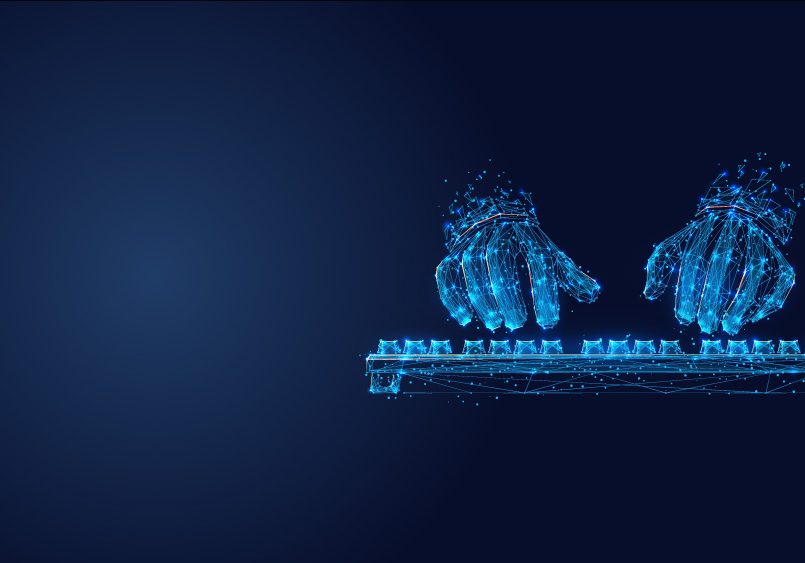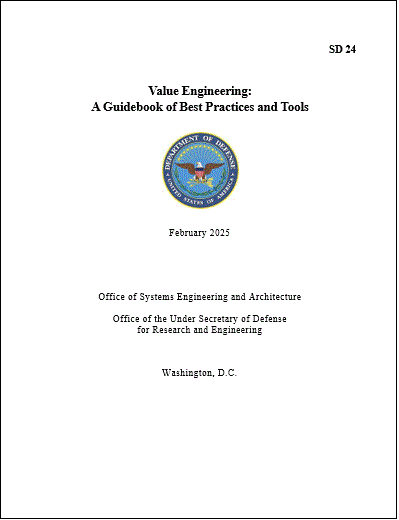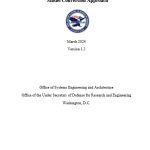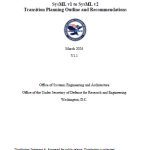SE&A News and Events
DoD Adopts Human Readiness Level Standard
The U.S. Department of Defense has officially adopted the ANSI/HFES 400-2021 Human Readiness Levels standard. This is a major leap forward in making sure mission-critical systems are not just technologically advanced but truly ready for the people who will use them.
In addition to the classic Technology Readiness Levels, DoD now has a powerful new way to measure how user friendly and effective these systems are for real-world operators.
See the standard for free Human Factors and Ergonomics Society website.
The goal is to build systems that work for people because human readiness is mission readiness!
SE&A Director of Specialty Engineering, Mr. Chris DeLuca, appeared on ABC’s Fed Gov Today on August 24 to discuss how DoD’s adoption of the Human Readiness Level (HRL) standard advances critical technology as well as safer human-centered systems. See a summary and video by Fed Gov Today:.
See also “DoD Adopts Standard for Human Readiness Levels” on the OUSD(R&E) news page
https://www.cto.mil/news/dod-hrl/
https://quicksearch.dla.mil/qsDocDetails.aspx?ident_number=285886
Released: Software Engineering for Continuous Delivery of Warfighting Capability
SE&A recently published Software Engineering for Continuous Delivery of Warfighting Capability, informally known as the “Software Engineering Guide.” This guide assists programs in adopting modern software development practices that apply more automation and engineering rigor to deliver better software faster in its mission to foster innovation and efficiency in rebuilding our military.
The guide is primarily intended for DoD program management offices, systems engineers, software engineers, software developers, testers, and acquisition officials. It is meant to help plan and execute software development in an environment of changing software technologies, software engineering practices, software requirements, and software acquisition practices.
Although the guide assumes the reader is familiar with traditional DoD systems and software engineering practices, it also discusses and references modern approaches such as the Software Acquisition Pathway, Agile, and DevSecOps.
The guide provides readers with information on policy and guidance, technology modernization, challenges and best practices, software metrics use, software engineering and workforce competencies, contracting for software engineering, and touches upon artificial intelligence implications for software engineering.
Software Engineering for Continuous Delivery of Warfighting Capability is available here
See also the SE&A Software Engineering web page: https://www.cto.mil/sea/swe/
SE&A info sheets: https://www.cto.mil/sea/info-sheets
AIA releases guidance “Contracting Quality Early in the Program Lifecycle”
The importance of including quality engineering resources early in the program life cycle cannot be overstated. Missed quality steps up front lead to costly defects, delays, and safety risks down the line.
This AIA guidance supported by the Joint Strategic Quality Council tackles the challenge of ensuring quality early. Learn about options for program managers to consider for best allocating scarce resources during the lifecycle.
Contracting Quality Early in the Program Lifecyle
https://www.aia-aerospace.org/publications/contracting-quality-early-in-the-program-lifecycle/
RELEASED: 2025 version of the Manufacturing Readiness Level (MRL) Deskbook
MRL criteria and metrics provide a standardized scale and vocabulary for assessing and discussing manufacturing maturity and risk. Using these tools, an MRL Assessment offers a structured method to evaluate manufacturing processes, procedures, and techniques across technologies, components, items, subsystems, and systems—fostering innovation and efficiency in rebuilding our military.
This document details best practices for conducting manufacturing assessments using the MRL criteria. It targets individuals responsible for performing these evaluations, including acquisition project managers, systems engineers, manufacturing managers, and leaders of technology development and demonstration projects.
View the deskbook here: dodmrl.org.
RELEASED: Application Programming Interface (API) Technical Guidance: Minimum Viable Capability Release (MVCR) 2
OUSD(R&E) Systems Engineering and Architecture (SE&A) released updated API Technical Guidance for DoD practitioners. MVCR-2 includes new content on software developer kits (SDKs) and libraries, real-time system (RTS) APIs, and data standards.
MVCR 1 builds on the previously released API guidance, which addresses a essential concepts in DoD software development, including definitions, governance, cybersecurity, design and implementation principles, development, security and operations (DevSecOps) and testing.
This guidance includes use cases, lessons learned, and best practices from DoD and industry. Although other guides exist, this guide emphasizes the importance of enhancing and advancing the DoD warfighting capabilities and to secure information interoperability across the DoD.
Find the guide Link in the SE&A Library: https://www.cto.mil/sea/pg | Software Engineering or click below.
RELEASED: Implementing a Modular Open Systems Approach in Department of Defense Programs
This guidebook provides the DoD community, including Military Services, civilians, and DoD support contractors with information to help ensure programs incorporate a modular open systems approach (MOSA) as part of the defense acquisition program life cycle. The audience includes decision makers, program management offices, program managers, and program lead systems engineers responsible for implementing and evaluating MOSA in defense programs.
Although MOSA has long been incorporated into DoD programs, this guidebook describes statute and DoD policy that now impose requirements to use MOSA. This guidebook provides best practices for planning, implementing, and evaluating MOSA, including implementation principles, benefits, challenges, and suggestions based on experience from practitioners in DoD and industry. It includes recommendations to consider when developing requests for proposals and evaluating planned approaches for implementing MOSA. The appendices provide supplemental information on the background efforts that have helped inform the DoD MOSA community.
The Office of the Under Secretary of Defense for Research and Engineering (OUSD(R&E)) Systems Engineering and Architecture (SE&A) prepared the guidebook and will continue to review, update, and incorporate feedback to acknowledge advances in the field.
SE&A website: https://www.cto.mil/sea
SE&A Library: https://www.cto.mil/sea/pg
SE&A Systems Engineering: https://www.cto.mil/sea/se
DoD MOSA Community of Practice: https://www.dau.edu/cop/mosa
RELEASED: SD-24 DoD Value Engineering (VE) Guidebook
OUSD (R&E) recently issued SD-24 Value Engineering: A Guidebook of Best Practices and Tools, an update of a 2011 version. VE is a sound and effective business practice that can yield significant returns on investment not only for cost, but also for capability performance and schedule.
DoD Components use VE to analyze programs, systems, services, products, and more to ensure they accomplish essential functions at the lowest life-cycle cost consistent with the required performance, quality and safety. Components retain their VE savings for allocation to other internal priorities to achieve a better value for the money.
The recent update to DoD Instruction 4245.14, “DoD Value Engineering Program,” is intended to reinvigorate VE and, along with this guidance, facilitate an understanding of responsibilities for VE programs and how to enhance DoD processes and products. VE is integral to supporting DoD’s national security mission.
This guidebook equips Components with information needed to establish and maintain viable VE programs. It describes the basics of the VE methodology, the benefits of a strong DoD VE Program, and best practices for applying VE on government contracts.
The publication is available here.
DoD Instruction 4245.14 is available here.
For more information on VE, visit its webpage at https://www.cto.mil/sea/ve/ and its Community of Practice webpage at https://www.dau.edu/cop/se/resources/value-engineering .
Released: Best Practices to Achieve Better Reliability and Maintainability (R&M) Estimates for DoD Systems
The guide assists DoD programs to improve R&M estimates by narrowing the gap between estimates made during the acquisition of a system and the achieved levels of R&M in the field. Better estimates support better forecasting of operating and support costs as well as increased mission effectiveness.
SE&A developed the guide in collaboration with participants from the DoD-Industry R&M Engineering Roundtable, which meets at the Annual Reliability and Maintainability Symposium (RAMS) to discuss and prioritize R&M challenges. The guide was submitted for peer review among the roundtable participants, the DoD R&M Service Leads, OUSD(R&E), and OUSD(A&S).
This guide is the first of a series of planned documents to address top R&M challenges. Follow-on documents will address R&M estimates at points in the acquisition cycle
including user requirements, concept development, development, DT&E, OT&E, and in-service.
The publication is available here.
SE&A R&M web page
https://www.cto.mil/sea/rm/
R&M Community of Practice
https://www.dau.edu/cop/rm-engineering
Released: DoD Software S&T Strategy Implementation Plan
The DoD Software Science and Technology (S&T) Strategy Implementation Plan provides information on planned S&T investments across DoD to promote alignment of investment to support future warfighting needs. The guide describes ongoing and planned research projects that may become candidates for prototyping and subsequent deployment at scale. For those planning research and development (R&D) of software-enabled capabilities, the guide provides awareness of a rapidly growing base of enterprise resources such as cloud infrastructure and software factory assets that can speed the development and delivery of research results to help initiatives cross the software “valley of death” from research to operational deployment.
The implementation guide is available on the SE&A Policy and Guidance page under the heading "Software Engineering."
Released: DoD Instruction 4245.14, DoD Value Engineering (VE) Program
Value engineering (VE) is a methodology used to reduce acquisition and ownership costs or delivery timelines, while maintaining or improving required functionality. VE is integral to supporting DoD’s national security mission.
R&E has released an updated DoD Instruction (DODI) 4245.14, DoD Value Engineering (VE) Program, to reinvigorate VE practice in the DoD.
DoD Components use VE to analyze programs, systems, services, products, and more to ensure they accomplish essential functions at the lowest life-cycle cost consistent with the required performance, quality and safety. Components retain their VE savings for allocation to other internal priorities to achieve a better value for the money.
Released: SysML Conversion Approach and Transition Outline
The approach and outline were developed as part of a project sponsored by the SE&A Digital Engineering, Modeling and Simulation (DEM&S).
Systems Modeling Language (SysML) Version 2 (v2) is the next generation of SysML, a standard modeling language used in systems engineering throughout industry and government. SysML v2 supports the evolving practice of model-based systems engineering (MBSE) to address challenges in increasing system complexity and rapid technology change. SysML v2 is intended to increase the effectiveness and adoption of MBSE by improving the language precision, expressiveness, regularity, and interoperability.
The paper "SysML v1 to SysML v2 Model Conversion Approach" presents a suggested approach for DoD programs to make the transition from SysML v1 to SysML v2. To illustrate the transition, the project team used a hypothetical system model, Skyzer Mission Model, developed by the https://sercuarc.org/ Systems Engineering Research Center, a DoD university-affiliated research center.
The SysML v1 to SysML v2 Transition Planning Outline and Recommendations suggests a five-step outline organizations can use and adapt as they plan the SysML transition.

Contact Us
For more information, contact osd-sea@mail.mil using the following subject line: Attn SE&A
Office of the Under Secretary of War,
Research and Engineering (OUSW(R&E))
3030 Defense Pentagon, Washington, DC 20301-3030
Contact Us
Contact Us
Information for the USD(R&E):
Contact OUSD(R&E) Staff
Social Media: @DoDCTO on Twitter
For website issues: Contact Webmaster











